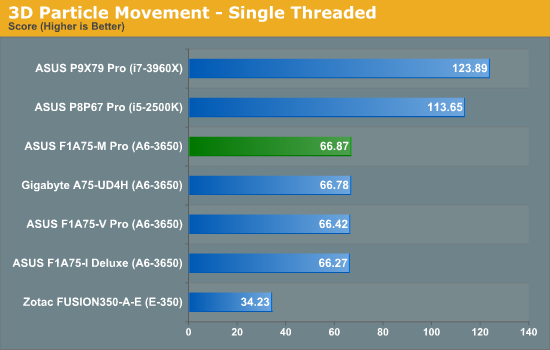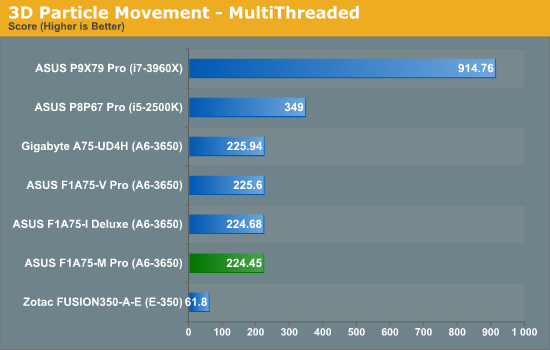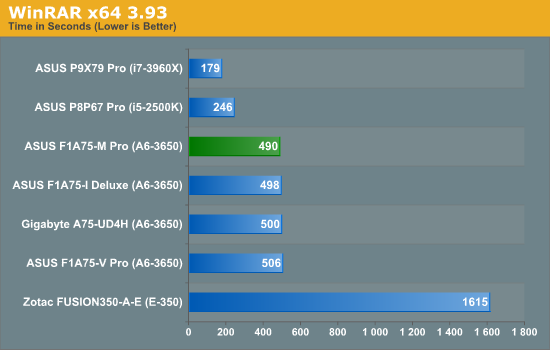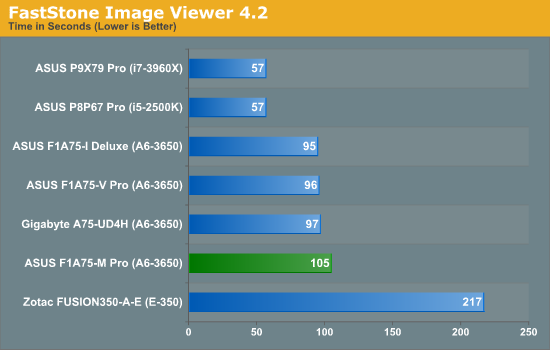ASUS F1A75-M Pro Review - Micro-ATX Llano at $110
by Brendan van Varik on January 22, 2012 2:00 AM EST- Posted in
- Motherboards
- Asus
- Llano
3D Movement Algorithm Test
The algorithms in 3DPM employ both uniform random number generation or normal distribution random number generation, and vary in various amounts of trigonometric operations, conditional statements, generation and rejection, fused operations, etc. The benchmark runs through six algorithms for a specified number of particles and steps, and calculates the speed of each algorithm, then sums them all for a final score. This is an example of a real world situation that a computational scientist may find themselves in, rather than a pure synthetic benchmark. The benchmark is also parallel between particles simulated, and we test the single thread performance as well as the multi-threaded performance.


While the F1A75-M Pro is the top A75 in Single Thread and the bottom A75 in Multithread for our 3DPM tests, neither results are vastly different from the other A75 boards, as expected.
WinRAR x64 3.93 - link
With 64-bit WinRAR, we compress the set of files used in the USB speed tests. WinRAR x64 3.93 attempts to use multithreading when possible.

The F1A75-M Pro secures top spot in our WinRAR benchmark for A75, beating the F1A75-I Deluxe by eight seconds.
FastStone Image Viewer 4.2 - link
FastStone Image Viewer is a free piece of software I have been using for quite a few years now. It allows quick viewing of flat images, as well as resizing, changing color depth, adding simple text or simple filters. It also has a bulk image conversion tool, which we use here. The software currently operates only in single-thread mode, which should change in later versions of the software. For this test, we convert a series of 170 files, of various resolutions, dimensions and types (of a total size of 163MB), all to the .gif format of 640x480 dimensions.

Somehow the FastStone test gave a score which was a lot lower than the other A75 boards. This result was extremely repeatable.
Sorenson Squeeze 6.0 - link
Sorenson Squeeze is a professional video encoder, complete with a vast array of options. For this test, we convert 32 HD videos, each a minute long and approximately 42 MB in size, to WMV 512KBps format. Squeeze can encode multiple videos at once, one for each thread.

On the lower powered systems, we see a wider spread of times for our Squeeze test, depending on the background software and/or other processes deciding to eat CPU time from a full install including vendor software. The F1A75-M Pro performs similarly to the A75-UD4H in this regard.










32 Comments
View All Comments
ASUSTechMKT - Monday, January 23, 2012 - link
Have not tested 3870K but tried the 3670K and was easily able to hit to 3.8GHz no APU bus adjustment just multipler. I tested this on -M, -V Pro, -V EVO and -I Deluxe. Make sure though you updated to the latest UEFI to correctly and fully support the K series APUs.ET - Sunday, January 22, 2012 - link
That "Level Up!!" text on the TurboV EVO screen made me think that it would be cool if playing with the BIOS could be made into a game. Give achievements for exploring the BIOS, up the user's hardware hacker level when he changes stuff successfully without making the PC unbootable.Basilisk - Sunday, January 22, 2012 - link
(Here's my chance to look dim.)Looking at the comparison table on the first page, I thought "Oh crud... they dropped eSata on the uATX board." eSata's my fetish, I suppose. Then I read the "Board Features" on "Inside the Box" and did a double-take when it listed "1 x eSATA 6 Gbps", so my hopes rose... until I looked a the pix of the back-panel and the box contents [for brackets].
Alas, I suspect you've a (minor) error and the eSata's missing. Even sadder that it's missing on the ITX board, as external resources and backups become even more valuable (to me) there.
Death666Angel - Sunday, January 22, 2012 - link
The ITX board has eSata on the I/O shield, just look at the review pics at the bottom of this page:http://www.anandtech.com/show/4833/asus-f1a75i-del... (It's between the clear CMOS and DVI and below the 2 red USB ports.)
This mATX board doesn't have eSata on the I/O shield and doesn't provide a PCI bracket, but you can always purchase one of those for $2. :-)
Soulkeeper - Sunday, January 22, 2012 - link
The mini-itx is expensive in part because of the wireless keyboard and wifi.It's worthless for overclocking mostly due to the lack of a higher bclk divider.
To be honest if I wanted a matx fm1 motherboard I'd go with gigabyte's solution.
ASUSTechMKT - Monday, January 23, 2012 - link
our - I Deluxe has been tested to reach the same performance numbers ( APU bus scaling and multipler scaling for K series as the rest of our F1A boards ( -V Pro or -M Pro ). latest UEFI is recommended if you want to have highest potential under both AHCI and IDE ranges.bobbyto34 - Monday, January 23, 2012 - link
thanks a lot for the dpc latency test ! It's very useful for musicians when you want to buy a rig for audio recording !DaneelSE - Monday, January 23, 2012 - link
One promising use for a u-ATX board is using it as a base for a HTPC build. Somehow there seem to be a lack of interest in this arena from reviewers.It would be very interesting to see a real life use scenario benchmarked with power usage. How low can we push a platform in power usage wjhile still performing a few mundane tasks simultaneously.
Just brainstorming here to give an example of possible tasks that would be run at the same time.
1. Watching a DVB-T HD-channel
2. Recording a second channel on a different MUX
3. Transcoding a third recording on low priority
4. Have a internet browser in the background with some predefined work load.
It would be very interesting to see this as a usage case where the reviewer tries to push the power usage down while conserving the end user experience.
I think it would be interesting to see how AMD probably beats Intel until Ivybridge get released and then possibly see a throne shift back and forth a few times.
cjs150 - Monday, January 23, 2012 - link
Sadly just about the only sensible use for Llano is in an HTPC build. (or as low powered laptop which it is very good at).Problem for me is that our cable operator (Virgin) has a TiVo box which lets me watch one channel and record 2 at same time so any HTPC build I do only really needs a mini-itx board (and complete silence!). Hoping that the reviews of Zotac's announcements at CES will take away need for building my own.
Anyway back to a proper HTPC build. The main issues are:
1. Noise. Fans not allowed (except at very low RPM). I want to hear the TV not the HTPC - this is a big problem for me with my Blu-ray player.
2. Sound. There is a big debate as to whether sound is better going through HDMI port or not. Personally I prefer fewer cables to more and my ears are not good enough to tell the difference so sound has tobe routed through HDMI
3. Picture quality: Obviously vital for an HTPC and a big plus for AMD, happy to use integrated graphics here provided (Intel note) frame rate is perfect. Using Integrated graphics frees up a PCI/PCI-E slot for something else.
4. TV card or cards: Dual channel is minimum acceptable.
So for me I can probably built a nice HTPC using mini-itx but if you want to use the full potential of a Micro-Atx you could build one say with 2xdual channel TV cards, separate sound card and GPU - cooling and noise would be an issue though
DaneelSE - Monday, January 23, 2012 - link
I fully understand the limitations and possibilities, and probably am able to work this out by myself.My comment was aimed at how a u-atx review is done. There are a few different target readers.
1. Gamers that want their box as small as possible (Did I hear Zotac Z68-ITX WiFi)
2. HTPC builders that want a all in one solution
3. Small desktop builds where the extra PCIe slots are vital
4. Small server/storage builds
I understand that every review can't cover all bases, but surely a HTPC oriented series of reviews would get a lot of clicks and readers.
Regarding your itemized list
1. good comment and I somehow think consumed power relates to cooling needed. Fan and noise belongs in Case-reviews.
2. Separate review, however the onboard quality should be measured, if nothing else using RMAA
3. I know that Anandtech has reviewers specialized in this area and it should of course be included if IGP is present, if nothing else to indicate when discrete is needed to reach acceptable levels.
4. Agree, wouldn't make sense otherwise, and still debatable if you really need to go as high as u-ATX.